Key:fuel:*
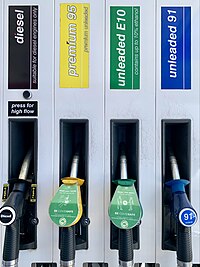 |
| Description |
|---|
| Describes fuel types. |
| Group: properties |
| Used on these elements |
| Useful combination |
| See also |
|
| Status: approved |
| taginfo: fuel:* |
Keys beginning with the prefix fuel:*=* indicate which types of fuel are available at a amenity=fuel, railway=fuel, waterway=fuel, aeroway=fuel, or shop=fuel. The keys without namespace are also used on amenity=bbq and man_made=kiln to describe the fuels used with the installed infrastructure, or to clarify the type of fuel indicated by substance=fuel or content=fuel.
How to map
Gasoline/petrol is preferably tagged by octane rating; when mapping, use the numerical ratings as displayed at the fuel pump, elsewhere at the fuel station, or as dictated by an applicable government or industry standard. In most countries this will be the Research Octane Number (RON). However, some countries—particularly Canada, the United States, and Mexico—use the arithmetic mean of RON and Motor Octane Number (MON), typically denoted "(R + M)/2" or "AKI" (Anti-Knock Index). Do not extrapolate a gasoline's RON or (R + M)/2 rating: there is no one-to-one correspondence between the two rating systems, and conversions between them are generally unverifiable.
Note that presence of some tags with yes value, such as fuel:octane_80=yes + fuel:octane_98=yes does not say anything about presence of other fuels[1]
To indicate that all available fuels are mapped people used fuel:others=no to mark that nothing else is available but this tag is fairly rare.
| Sub type | Tagging | Remark | Taginfo |
|---|---|---|---|
| Diesel | |||
| Heating oil | fuel:heating_oil=yes
|
Heating oil is any petroleum product or other oil used for heating. |
|
| Diesel | fuel:diesel=yes
|
Combustible liquid fuel used in combustion engines. Called "nafta" in Argentina, Paraguay and Uruguay and "bencina" in Chile. |
|
| GTL diesel | fuel:GTL_diesel=yes
|
High quality partly synthetic diesel made using the 'Gas To Liquid' method: "ultimate diesel", "V-Power diesel", etc. |
|
| HGV diesel | fuel:HGV_diesel=yes
|
High-output pumps with a larger nozzle that won't normally fit a motorcar fuel receptacle. |
|
| Diesel B0 | fuel:diesel_b0=yes
|
Pure diesel fuel without any renewable components. In Europe usually explicitly marked as such for special purposes. |
|
| Diesel B7 | fuel:diesel_b7=yes
|
Diesel with up to 7% content of renewable components, the common diesel type in the EU. Usually tagged as fuel:diesel=yes
|
|
| Diesel B10 | fuel:diesel_b10=yes
|
Diesel with an increased amount of renewable components, up to 10%, available in the EU |
|
| Diesel s10 | fuel:diesel_s10=yes
|
Diesel with a specified limited amount of sulfur (10mg/kg), used in Brazil. Usually tagged as fuel:diesel=yes as this is the default in many regions, including the EU.
Also in use are the tags |
|
| Diesel s500 | fuel:diesel_s500=yes
|
Diesel with a limited (but comparably large) amount of sulfur of up to 500 mg/kg, used in Brazil.
Also in use are the tags |
|
| Bio diesel | fuel:biodiesel=yes
|
Diesel made from renewable sources, e.g. vegetable oil. Often marked as "XTL", "HVO", "HVO100" or "B100" |
|
| Cold weather diesel | fuel:diesel:class2=yes
|
Diesel for colder weather climates (with a threshold filtration temperature of −32 °C), on the EU EN590 scale. Can be branded as "winter diesel", "Arctic diesel", "diesel −32 °C", etc., depending on the location. Class 2 appears to be the most widely sold variety in Scandinavia and the EEU, however you can replace the "2" in fuel:diesel:class2=yes with 0 (to describe diesel with a threshold filtration temperature down to −20 °C); 1 (−26 °C); 3 (−38 °C) and 4 (−44 °C).
Note that there is a separate threshold for milder, "winter" diesel (A–F, +5 to −20 °C) not covered by this tag, however similar syntax could be used |
|
| Untaxed diesel | fuel:taxfree_diesel=yes
|
Diesel fuel with few or no taxes, typically for agricultural, construction, or other off-road use. May be known by names such as agricultural diesel, off-road fuel, red diesel (from the dye used to mark it as untaxed), etc. |
|
| Gasoline/petrol | |||
| Octane 80 | fuel:octane_80=yes
|
| |
| Octane 85 | fuel:octane_85=yes
|
"regular" in many of the Mountain states ( |
|
| Octane 86 | fuel:octane_86=yes
|
| |
| Octane 87 | fuel:octane_87=yes
|
"regular"( |
|
| Octane 88 | fuel:octane_88=yes
|
| |
| Octane 89 | fuel:octane_89=yes
|
"mid-grade"( |
|
| Octane 90 | fuel:octane_90=yes
|
"Pertalite"( |
|
| Octane 91 | fuel:octane_91=yes
|
"premium"( |
|
| Octane 92 | fuel:octane_92=yes
|
"premium"( |
|
| Octane 93 | fuel:octane_93=yes
|
"premium" ( |
|
| Octane 94 | fuel:octane_94=yes
|
"Ultra 94" (Petro-Canada), "Supreme Plus 94" (Chevron, Esso) ( |
|
| Octane 95 | fuel:octane_95=yes
|
"Benzina Verde"( |
|
| Octane 97 | fuel:octane_97=yes
|
Found in |
|
| Octane 98 | fuel:octane_98=yes
|
"Super Plus"( |
|
| Octane 100 | fuel:octane_100=yes
|
"V-Power" (Shell), "MaxxMotion Super 100plus" (OMV) |
|
| Octane 102 | fuel:octane_102=yes
|
"Ultimate 102" (Aral) |
|
| Unspecified "premium" | fuel:premium=yes
|
Some kind of gasoline with an unknown Octane rating. Use only if the precise rating is unknown. If possible, tag the precise rating. Often fuel:octane_91=*( |
|
| Unspecified "midgrade" | fuel:midgrade=yes
|
Some kind of gasoline with an unknown Octane rating. Use only if the precise rating is unknown. If possible, tag the precise rating. Often fuel:octane_89=*( |
|
| Unspecified "regular" | fuel:regular=yes
|
Some kind of gasoline with an unknown Octane rating. Use only if the precise rating is unknown. If possible, tag the precise rating. Often fuel:octane_87=*( |
|
| Unspecified gasoline | fuel:gasoline=yes
|
Some kind of gasoline with an unknown Octane rating. Use only if the precise rating is unknown. If possible, tag the precise rating. |
|
| Unspecified petrol | fuel:petrol=yes
|
Some kind of gasoline with an unknown Octane rating. Use only if the precise rating is unknown. If possible, tag the precise rating. |
|
| Mixtures | |||
| 1:25 | fuel:1_25=yes
|
Mix of gas with 1/25 oil. |
|
| 1:50 | fuel:1_50=yes
|
Mix of gas with 1/50 oil. |
|
| Formulas | |||
| Ethanol | fuel:ethanol=yes
|
Pure ethanol fuel. |
|
| Alcohol | fuel:alcohol=yes
|
Pure ethanol fuel. More commonly tagged fuel:ethanol=*.
|
|
| Ethanol-free | fuel:ethanol_free=yes
|
Ethanol-free gasoline suitable for cars, boats, or small engines |
|
| Methanol | fuel:methanol=yes
|
| |
| E0 | fuel:e0=yes
|
Ethanol-free gasoline. More often tagged fuel:ethanol_free=*.
|
|
| E5 | fuel:e5=yes
|
| |
| E10 | fuel:e10=yes
|
10% ethanol content gasoline mix. Common in the |
|
| E12 | fuel:e12=yes
|
12% ethanol content gasoline mix. Other local name: Super Etanol |
|
| E15 | fuel:e15=yes
|
15% ethanol content gasoline mix. Often referred to as Gasohol E15. |
|
| E20 | fuel:e20=yes
|
20% ethanol content gasoline mix. Often referred to as Gasohol E20. |
|
| E85 | fuel:e85=yes
|
85% ethanol/15% gasoline for flexi-fuel cars in USA and Europe. Popular in |
|
| E100 | fuel:e100=yes
|
Gasoline consisting of 100% Ethanol. More often tagged fuel:ethanol=*.
|
|
| Biogas | fuel:biogas=yes
|
"SunGas(r)". Also known as compressed biogas (CBG). It is primarily methane and produced from waste (municipal, green, food, etc.). |
|
| LPG | fuel:lpg=yes
|
Liquefied Petroleum Gas, liquid mixture of mostly propane and butane. Often colloquially called "propane", although the mixture can vary depending on region, climate and season. If a content of at least 95% propane is guaranteed, fuel:propane=yes can be used instead.
Other local names: Autogas |
|
| Propane | fuel:propane=yes
|
Liquefied Petroleum Gas, liquid mixture of at least 95% propane and balance butane. Note: In many regions the colloquial name "propane" refers to any kind of LPG and not to pure propane fuel. If the mixture is unknown, use fuel:lpg=yes.
|
|
| CNG (compressed natural gas) | fuel:cng=yes
|
Mainly methane compressed to 200–248 bars. A fossil gas. Other local names: Erdgas |
|
| LNG (liquefied natural gas) | fuel:lng=yes
|
LNG, GNL: much less common than LPG and CNG, but used in some places. Mostly methane content |
|
| Butane | fuel:butane=yes
|
Butane |
|
| Liquid hydrogen | fuel:LH2=yes
|
Liquid H2 |
|
| Gaseous hydrogen | fuel:h35=yes
|
Gaseous H2 35 MPa / 350 bar |
|
| Gaseous hydrogen | fuel:h50=yes
|
Gaseous H2 50 MPa / 500 bar |
|
| Gaseous hydrogen | fuel:h70=yes
|
Gaseous H2 70 MPa / 700 bar |
|
| Aviation fuel at aeroway=fuel | |||
| 91UL (clear) | fuel:91UL=yes
|
91 octane unleaded aviation gas |
|
| 100LL (blue) | fuel:100LL=yes
|
100 octane leaded aviation gas. Duplicates of this tag include fuel:avgas_100_ll=* and fuel:AVGAS_100LL=*.
|
|
| autogas | fuel:autogas=yes
|
Ethanol free unleaded gas suitable for cars or planes |
|
| Jet A-1 | fuel:JetA1=yes
|
Jet A-1 fuel for gas-turbine and diesel powered planes. The tag fuel:jet_A=yes is also in use and depending on the case might or might not be identical.
|
|
| Non-liquids | |||
| Coal | fuel:coal=yes
|
| |
| Anthracite | fuel:anthracite=yes
|
Special form of coal. |
|
| Coke | fuel:coke=yes
|
Coke from coal |
|
| Coal briquette | fuel:coal_briquette=yes
|
Pressed or cut coal block |
|
| Lignite | fuel:lignite=yes
|
Lignite, often referred to as brown coal, is a soft, brown, combustible, sedimentary rock formed from naturally compressed peat. |
|
| Bituminous coal | fuel:lignite_briquette=yes
|
Briquettes formed from lignite |
|
| Wood | fuel:firewood=yes
|
Wood as a heat source |
|
| Wood pellets | fuel:wood_pellets=yes
|
Wood in pellet form |
|
| Wood briquette | fuel:wood_briquette=*
|
Wood in briquette form |
|
| Charcoal | fuel:charcoal=yes
|
Charcoal as a heat source |
|
| Additives | |||
| AdBlue/AUS32 | fuel:adblue=yes
|
32.5% aqueous urea solution, widely known as AdBlue® (one of many brands, however used most often when referring to AUS32). Used by modern trucks and some motorcars. pt-BR: ARLA 32. Use this tag for places where e.g. there is a standalone AdBlue pump with a nozzle. These are generally used for HGVs, however can also be used for motorcars. See fuel:adblue:canister=yes for AdBlue sold in canisters.
|
|
| AdBlue/AUS32 sold in canisters | fuel:adblue:canister=yes
|
Use for places where there is no AdBlue pump, but rather AdBlue is sold in canisters/other packaging, requiring manual handling and filling - this might not be suitable/convenient for some vehicles. May be used for refilling both HGVs and motorcars. |
|
| Engine oil | fuel:engine_oil=yes
|
Any one of various substances used for the lubrication of internal combustion engines |
|
| Gear oil | fuel:gear_oil=yes
|
Gear oil is a lubricant made specifically for transmissions, transfer cases, and differentials in automobiles, trucks, and other machinery. It is of a high viscosity and usually contains organosulfur compounds. |
|
| Possible Duplicates and Mistakes | |||
| HVO 100 | fuel:hvo100=yes
|
HVO100 is a marketing term for a specific process to produce diesel from plants. Use fuel:biodiesel=*.
|
|
| SVO | fuel:svo=yes
|
SVO is a marketing term for a specific process to produce diesel from plants. Use fuel:biodiesel=*.
|
|
| B7 | fuel:b7=yes
|
B7 is the short name of a specific diesel mixture. Use fuel:diesel_b7=*.
|
|
| B10 | fuel:b10=yes
|
B10 is the short name of a specific diesel mixture. Use fuel:diesel_b10=*.
|
|
| B20 | fuel:b20=yes
|
B20 is the short name of a specific diesel mixture. Use fuel:diesel_b20=*.
|
|
| GPL | fuel:GPL=yes
|
Some languages use the abbreviation GPL instead of the English LPG. Use fuel:lpg=*.
|
|
| GNV | fuel:GNV=yes
|
Some languages use the abbreviation GNV instead of the English CNG. Use fuel:cng=*.
|
|
| gasoline_87 | fuel:gasoline_87=yes
|
Gasoline with a octane rating of 87. Use fuel:octane_87=*.
|
|
| gasoline_91 | fuel:gasoline_91=yes
|
Gasoline with a octane rating of 91. Use fuel:octane_91=*.
|
|
| gasoline_95 | fuel:gasoline_95=yes
|
Gasoline with a octane rating of 95. Use fuel:octane_95=*.
|
|
| avgas | fuel:avgas=yes
|
Unknown kind of gasoline for aviation. Check whether fuel:91UL=* or fuel:100LL=* is applicable.
|
|
| H2 | fuel:H2=yes
|
Unknown kind of hydrogen. Check which of the tags listed above are correct - can be liquid or gaseous at different pressures |
|
United States
Unleaded fuel in the United States is typically marketed as "regular", "mid-grade" or "plus", and "premium", both on monument signage and at the pump. However, if possible, you should tag a more specific octane ratings (as fuel:octane_*=yes), since the octane ratings of "regular", "mid-grade" and "premium" grades may vary from gas station to gas station. The octane rating for each grade is labelled on the pump, on a bright yellow square affixed to the nozzle or nearby, as required by federal regulation. [1]
Octane ratings are measured according to the AKI formula. Some states mandate minimum octane ratings, but the actual octane rating being sold may be higher.
E85 gasoline (with an octane rating of 94–96) should be tagged fuel:e85=yes.
Examples
-
United States:
fuel:unleaded=yesfuel:diesel=yes
(If possible, tag the octane numbers of unleaded fuel indicated at the pump.) -
United States:
fuel:unleaded=yesfuel:diesel=yesfuel:taxfree_diesel=yes
(If possible, tag the octane numbers of unleaded fuel indicated at the pump.) -
United States:
fuel:octane_87=yesfuel:octane_88=yesfuel:octane_89=yesfuel:octane_90=yesfuel:octane_91=yesfuel:e10=yes
(10% ethanol content is unremarkable but can be tagged.) -
United States:
fuel:e85=yesfuel:octane_93=yesfuel:octane_89=yesfuel:octane_*=yes
(Also tag the octane rating for "Regular".) -
United States:
fuel:e85=yes[2]fuel:e15=yes[2]fuel:octane_88=yes?[3]fuel:octane_87=yesfuel:octane_89=yesfuel:octane_93=yes
(Beware the out-of-order octane numbers!)
Notes
- ↑ https://lists.openstreetmap.org/pipermail/tagging/2023-April/067213.html
- ↑ 2.0 2.1 According to this warning label above the nozzles at left, the 88-octane fuel in blue is E15, and the flex fuel in yellow has 51–83% ethanol content, which is better known as E85 fuel.
- ↑ Should the octane number of an alternative fuel be tagged explicitly, as if it were a standard unleaded fuel?






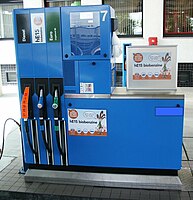



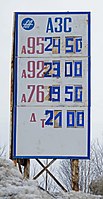

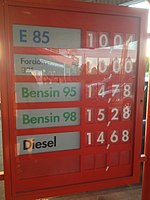




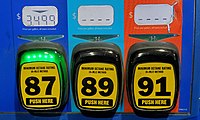
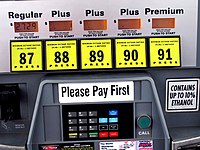

![United States: fuel:e85=yes[2] fuel:e15=yes[2] fuel:octane_88=yes?[3] fuel:octane_87=yes fuel:octane_89=yes fuel:octane_93=yes (Beware the out-of-order octane numbers!)](https://upload.wikimedia.org/wikipedia/commons/thumb/0/0d/Flex_Fuel_and_Unleaded_88_gas_pump.jpg/200px-Flex_Fuel_and_Unleaded_88_gas_pump.jpg)
